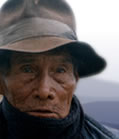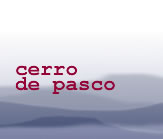THEMES IN THIS
TESTIMONY
Conflict

Culture and Customs

Economics

Education

Health

Migration

Politics

Social Relationships

Click on arrows
to find more
testimonies
featuring
these themes
|
|
Sex
|
male
|
|
|
Age
|
20
|
|
|
Occupation
|
student
|
|
|
Location
|
Lima
|
|
|
Date
|
1995
|
|
summary
Wilmer Eliseo Macha is the son of a miner from La Oroya. He came to La Oroya when he was two and has spent most of his life there, but recently moved to Lima in order to go to university. He was interviewed in Lima. He is a self-employed trader, and hopes to pass the university entrance examination and study business or accounting.
Wilmer talks about his parents and their life in their communities of origin and, later, in La Oroya. He describes life in La Oroya: the changes, the lack of opportunities for young people and the town's dependence on the activities of Centromin.
Although Wilmer exposes negative aspects of life in a mining camp - for example, pollution and health problems - he also is quick to point out that people in La Oroya are friendly, and that there is warmth and solidarity within the camps. He contrasts this attitude with that of people in Lima who seem to be hostile and out to take advantage of newcomers: “… they look for your weak points”. Wilmer also discusses local customs, celebrations and traditional dances. He concludes that as long as La Oroya fails to offer young people a better future, they will continue to leave. Many of his descriptions and examples are vivid and detailed.
detailed breakdown
|
You will need a password from Panos to view the full
transcript of the interview. To apply for a password, click here.
Once you have a password, click here to go to the beginning
of the transcript. You can also click on any section of the
breakdown of content below and go straight to the
corresponding part of the transcript.
|
| Section 1 |
Discusses family background: parents came to work in La Oroya, aged 20 and 17. They both came from farming communities
|
| Section 2 |
Effects of droughts in grandparent's community: suffering, famine and survival strategies (drinking liquid in cactus plants).
His father didn’t want to stay on the farm, “wanted to improve himself”: left home age 12 for Huancayo, got work and managed to continue with school.
|
| Section 3 |
Family religious background. Wilmer’s family moved to La Oroya in 1976 when his father got a job with Centromin.
|
| Section 4 |
Lima versus La Oroya: contrasts the friendliness of the mining camp with the impersonal/cold attitude of people in Lima. In-migration once common: La Oroya is populated by migrants from other towns and communities of the Mantaro Valley: “… it's cosmopolitan.”
|
| Section 5 |
Out-migration now common: Centromin is the reason for La Oroya's existence, being the only source of employment. Its decline means that people no longer come to La Oroya, instead they leave. “Any youth who wants to improve himself has to leave by the time he is 16, 17.” Lack of job opportunities means most young people see no future there
Environmental problems in La Oroya: pollution, proximity of camps to smelters. Describes health problems related to pollution and mine work.
|
| Section 6 |
Workers have formed cooperatives to provide an alternative to the unemployment generated by privatisation policies. He discusses changes in working conditions as a result of privatisation: temporary contracts, uncertainty, no labour rights. Tells story illustrating dangers of working in the arsenic plant, describing a friend whose skin had been affected: “If he was like that after four days, can you imagine what he'll be like in three months? The worse thing is he doesn't know how much he'll get paid.”
|
| Section 7 |
La Oroya is well equipped with primary/secondary education provided by Centromin, but few young people few stay, due to lack of job opportunities. Most go to Lima, Huancayo or Cerro de Pasco.
His plans for university; the difficulties he encountered in Lima, arriving knowing no one, coming from a mining camp, but you “start adapting…”
|
| Section 8 |
Differences between Lima and La Oroya, eg customs, labour day celebrations
|
| Section 9 |
Discusses preparation of pachamanca (meat and vegetables cooked in underground ovens), tamales. Preparation of local food is passed on from generation to generation. Local celebration/festivities: cortamonte during the carnival, the arrival of the Three Wise Men, yunsas (big party). Traditional dances: huaynito, huaylash, santiagos (still popular among the younger generations).
|
| Section 10 |
Explains that even though other music like salsa, cumbia and chicha is popular among youths, traditional local music is not lost. Vivid descriptions of the dances
Changes in La Oroya: young people leave; others choose to work in trading instead of mining, but there are too few people able to buy goods.
|
| Section 10-11 |
The family business in La Oroya: its success and failure is linked to the performance of Centromin, just as La Oroya's growth depends on the industry. The effects of 1990’s “Fujishock” (economic stabilisation policy/stuctural adjustment, named after the Prime Minister, a Peruvian of Japanese origin).
His father is a union leader. Implications of his involvement: death threats, disagreements within the family, pressure from government, paramilitary group and Shining Path.
|
| Section 12 |
The difficulties of life during Shining Path activities and former President Alan Garcia's policies: bombs, tension, detentions etc; weakens workers’ organisations and their businesses.
Survival strategies during strikes: community kitchens (ollas comunes), solidarity and cooperation among the people- role of women and men
Changes: since 1992 no more strikes. Workers are more cautious due to the repeal of fixed contracts; privatisation initiatives; unfavourable labour laws
|
| Section 13-14 |
Lack of alternatives means miners do not want to risk losing jobs. Many have been fired. Most return to community of origin when they stop working.
Wilmer's goal is to go to university and study business, not interested in mining |
|


